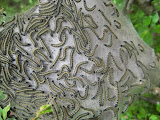Companies increasingly are running into water-related obstacles. Last week,
New York State denied a permit for Entergy’s
Indian Point nuclear power
plant because of its enormous consumption of cooling water.
Environmental Protection Agency issued new water
quality rules that could limit mining company operations. And in California, regulators recently pressured the utility giant
FPL Group to use more water-efficient technology in a
solar power plant project while denying access to water supplies to other developers.
“Unlike carbon, water use isn’t fungible,” Mr. Alexander said. “You can’t offset a water shortage in one region with credits in another region.”
Nonprofit Group Will Prod Companies to Report Their Water Use.
Most of the direct water use, is accounted for by the broad categories of
power generation and agriculture. As for individual sectors, almost all use more water indirectly than directly. For example, in
cane sugar refining, relatively little water is used at the mills. More than 95 percent is used indirectly, to grow the cane, generate electricity for the mills and in other parts of the
supply chain.
“If you’re doing a lifecycle assessment
, you want to make sure you include upstream activities that are water intensive,” Dr. Hendrickson said. “This tool should allow people to understand the implications of water use.”
Technorati Cosmos: other blogs commenting on this post

 Study of the relationships between organisms and their environment. Physiological ecology focuses on the relationships between individual organisms and the physical and chemical features of their environment. Behavioral ecologists study the behaviours of individual organisms as they react to their environment. Population ecology is the study of processes that affect the distribution and abundance of animal and plant populations. Community ecology studies how communities of plant and animal populations function and are organized; it frequently concentrates on particular subsets of organisms such as plant communities or insect communities. Ecosystem ecology examines large-scale ecological issues, ones that often are framed in terms of measures such as biomass, energy flow, and nutrient cycling. Applied ecology applies ecological principles to the management of populations of crops and animals. Theoretical ecologists provide simulations of particular practical problems and develop models of general ecological relevance.
Study of the relationships between organisms and their environment. Physiological ecology focuses on the relationships between individual organisms and the physical and chemical features of their environment. Behavioral ecologists study the behaviours of individual organisms as they react to their environment. Population ecology is the study of processes that affect the distribution and abundance of animal and plant populations. Community ecology studies how communities of plant and animal populations function and are organized; it frequently concentrates on particular subsets of organisms such as plant communities or insect communities. Ecosystem ecology examines large-scale ecological issues, ones that often are framed in terms of measures such as biomass, energy flow, and nutrient cycling. Applied ecology applies ecological principles to the management of populations of crops and animals. Theoretical ecologists provide simulations of particular practical problems and develop models of general ecological relevance.
![Reblog this post [with Zemanta]](http://img.zemanta.com/reblog_b.png?x-id=0119e107-29b2-4bbd-978b-83e59a80f0f2)


![Reblog this post [with Zemanta]](http://img.zemanta.com/reblog_b.png?x-id=e449d7da-d151-4966-a55d-d5843ff1db68)